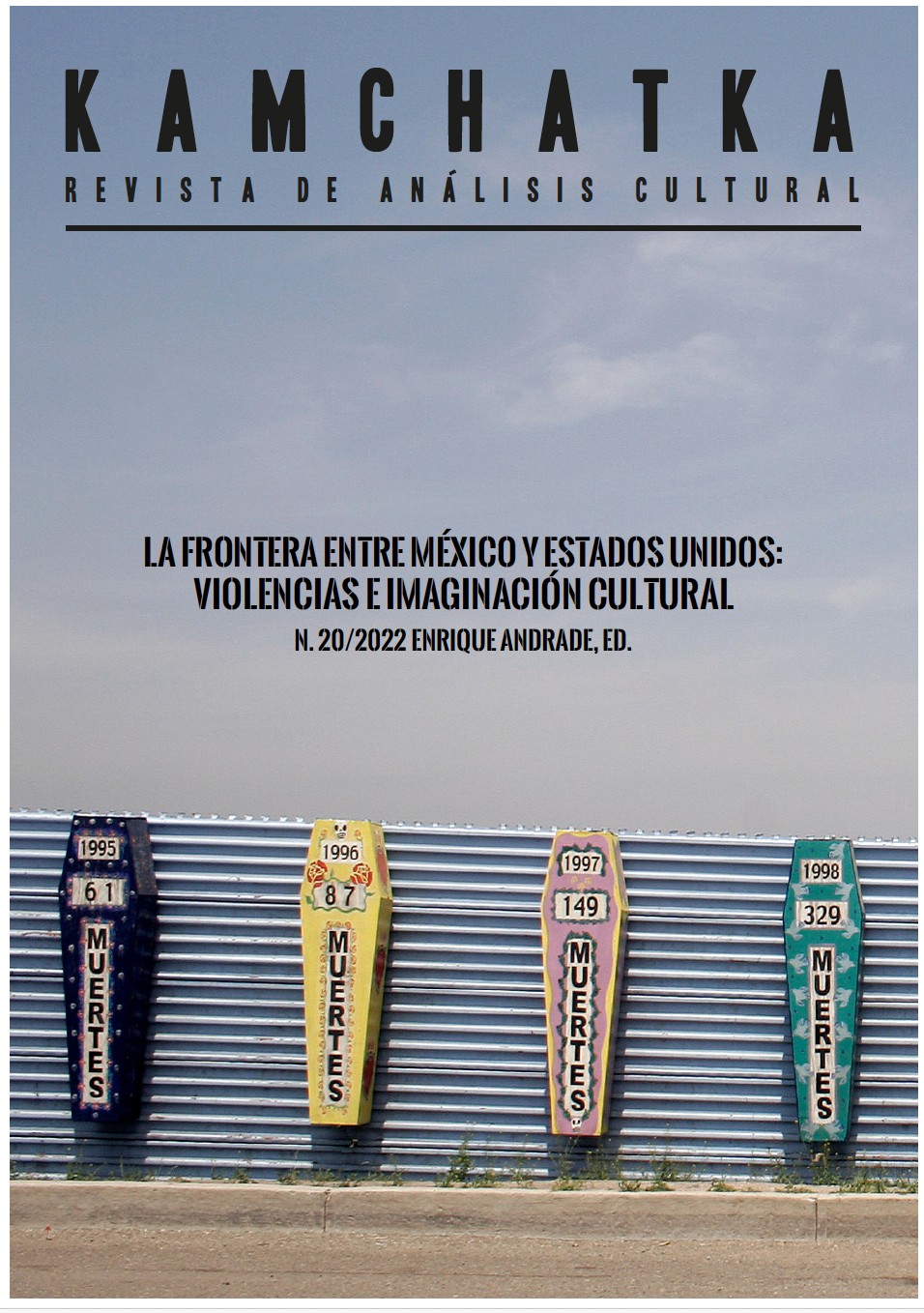Reenactment as Social Action: The Making of 'Encierro'
DOI:
https://doi.org/10.7203/KAM.20.24480Keywords:
reenactment, post-industrial, play, activism, beyond representation Abstract
Abstract
Before a documentary film becomes representation —something about reality— it is an event that happens in reality. It is a creative and social process that intervenes in the place and historical time where it takes place. This article builds from the artistic research I developed for the film project Encierro, a documentary recreation of a mining strike in my hometown of Almadén (Ciudad Real) in 1984. It explores the capacity of fieldwork, artistic methodologies, and documentary filming to intervene directly in reality and go beyond documentation, representation, and signification processes. Encierro is based on a local historical event, in which 11 miners locked down as a protest 650 meters underground in the mercury mines of Almadén for 11 days. This project proposes a similar underground lockdown of 11 people and 11 days 35 years later, now when the mine of Almadén is closed for production and we suffer the ruinous effects of the lack of restructuring plans. Ultimately, this reenactment raises the question of whether the recreation of a strike can also be considered as such, even though in post-industrial Almadén there is no more mining, no more production to close, and this “strike” does not come from a labor action, but from artistic practice.
 Downloads
Downloads
 References
References
Adriaansen, Robbert-Jan (2020). “Play”. Agnew, Vanessa; Lamb, Jonathan; Tomann, Juliane (eds.). The Routledge Handbook of Reenactment Studies: Key Terms in the Field. New York: Routledge: 178-182.
Arns, Inke (2007). History Will Repeat Itself: Strategies of Re-enactment in Contemporary (Media) Art and Performance. También en Documentairfilmplatform Zone, Gent. [EN/NL]
Bateson, Gregory (1972). “A Theory of Play and Fantasy”. Salen, K.; Zimmerman, E. The Games Design Reader: A Rules of Play Anthology. (2006). Cambridge, MA: The MIT Press: 314-328.
Benjamin, Walter (1978). Reflections: Essays, Aphorisms, Autobiographical Writing. Jephcott, Edmund (trad.); Demetz, Peter (ed.). New York: Schocken Books.
Blázquez, Elena (2016). “Sobre recreaciones históricas y de memoria en el arte contemporáneo”. Macé, Jean François; Martínez Zauner, Mario (coords.). Pasados de violencia política: memoria, discurso y puesta en escena. Madrid: Anexo: 85-110.
Bolt, Barbara (2004). Art Beyond Representation: The Performative Power of the Image. London: I.B. Taurus & Co.
Bonnett, Alastair (2016) The Geography of Nostalgia: Global and Local Perspectives on Modernity and Loss. London: Routledge.
Boym, Svetlana (2001) The Future of Nostalgia. New York: Basic Books.
Caillois, Roger (2001). Man, Play and Games. Champagne, Illinois: University of Illinois Press.
Carlson, Marvin (1996). Performance: A Critical Introduction. London: Routledge.
Demos, T.J. “Blackout: The Necropolitics of Extraction”. Dispatches, Issue 1/Article 1 (2018): 1-27.
Dezeuze, Anna. “Origins of the Fluxus score”. Performance Research: A Journal of the Performing Arts 7:3 (2002): 78-94.
Durkheim, Émile (1915). The Elementary Forms of the Religious Life: A Study in Religious Sociology. Ward Swain, Joseph (trad.). London: Allen & Unwin; New York: Macmillan.
Fink, Eugen. “The Oasis of Happiness: Toward and Ontology of Play”. Yale French Studies vol. 41 (1968): 19-30.
Goffman, Erving (1974). Frame Analysis: An Essay on the Organization of Experience. Boston: Northeastern University Press.
Harren, Natilee (2020) Fluxus Forms: Scores, Multiples, and the Eternal Network. Chicago: University of Chicago Press.
Ivens, Joris “Repeated and Organized Scenes in Documentary Film”. Ausbau 10/8. European Foundation Joris Ivens (1954): 1-9.
Jasen, Sylvie (2011). Reenactment as Event in Contemporary Cinema. Tesis doctoral. Ottawa: Carleton University.
Konuk, Kader (2020). “Mimesis”. Agnew, Vanessa; Lamb, Jonathan; Tomann, Juliane (eds.). The Routledge Handbook of Reenactment Studies: Key Terms in the Field. New York: Routledge: 142-146.
Mezzadra, Sandro y Brett Neilson. “On the Multiple Frontiers of Extraction: Excavating Contemporary Capitalism”. Cultural Studies 31/2-3 (2007): 185-204.
O’Sullivan, Simon. “The Aesthetics of Affect: Thinking Art beyond Representation”. Angelaki: Journal of the Theoretical Humanities 5/3 (2001): 125-135.
Salen, Katie, y Eric Zimmerman (2003) Rules of Play: Game Design Fundamentals, Cambridge, Massachusetts: The MIT Press.
Schechner, Richard (1985). Between Theatre and Anthropology. Philadelphia: The University of Pennsylvania Press.
Schneider, Rebecca (2011) Performing Remains: Art and war in times of theatrical reenactment. Routledge: New York.
Schroeder, Jonathan D. S. (2020) “Nostalgia”. Agnew, Vanessa; Lamb, Jonathan; Tomann, Juliane (eds.). The Routledge
Handbook of Reenactment Studies: Key Terms in the Field. Nueva York: Routledge: 156-159.
Solnit, Rebecca (2016) Hope in the Dark: Untold Histories, Wild Possibilities., Chicago: Haymarket Books.
Taussig, Michael (1993). Mimesis and Alterity: A Particular History of the Senses. New York: Routledge.
Turner, Victor (1986). The Anthropology of Experience. Chicago: Illinois University Press.
Turner, Victor (1997 [1990]). “Are There Universals of Performance in Myth, Ritual, and Drama?”. Schechner, Richard; Appel, Willa (eds.). By Means of Performance: Intercultural Studies of Theatre and Ritual. Cambridge: Cambridge University Press: 8-18.
Biberman, Herbert J. (1954). The Salt of the Earth.
Figgis, Mike and Jeremy Deller (2001). The Battle of Orgreave.
Godmilow, Jill (1984). Far From Poland.
Greene, Robert (2018). Bisbee’17.
Ivens, Joris (1934). Misère au Borinage.
Jennings, Humphrey (1943). The Silent Village.
Leacock, Philip (1952). The Brave Don’t Cry.
Riggen, Patricia (2015). Los 33.
Rouch, Jean (1961). La Pyramide Humaine.
Rouch, Jean (1954/1967). Jaguar.
Rouch, Jean (1969). Petit à Petit.
Sanjinés, Jorge (1971). El Coraje del Pueblo.
Schuster, Harold (1960). Hope.
Downloads
Published
How to Cite
-
Abstract743
-
artículo PDF (Español)314
Issue
Section
License
This journal provides an immediate free access to the content on the principle that freely make investigation available to the public, which promotes an increased global knowledge exchange.
Unless otherwise indicated, texts published in this journal are under the license Attribution-NonComercial 4.0 by Creative Commons. These texts may be copied, distributed and publicly communicated whenever the publication’s author and title are quoted and whenever they are not used for commercial purposes. In any case, intellectual property of the articles and its potential economic rights entirely belong to its authors.
The full license can be consulted on https://creativecommons.org/licenses/by-nc/4.0/. We encourage authors to disseminate papers published in Kamchatka. Journal of cultural analysis electronically, in institutional digital repository or in their websites.





